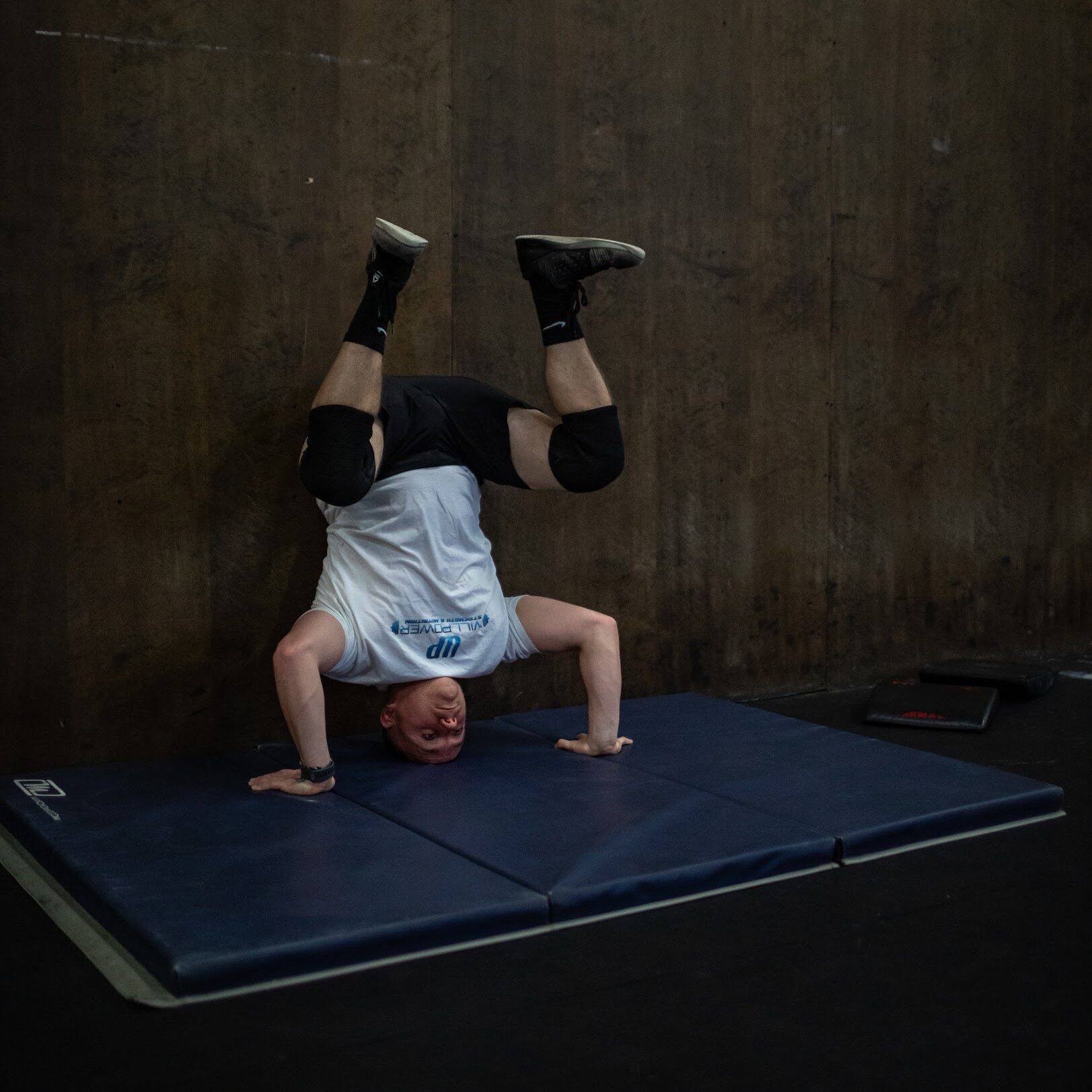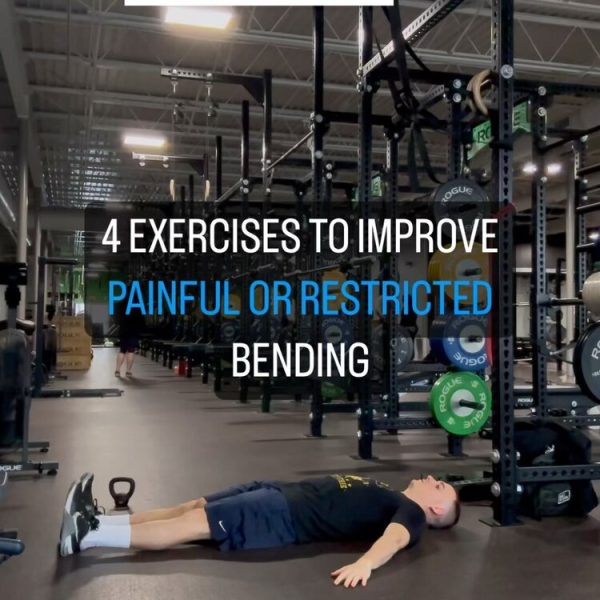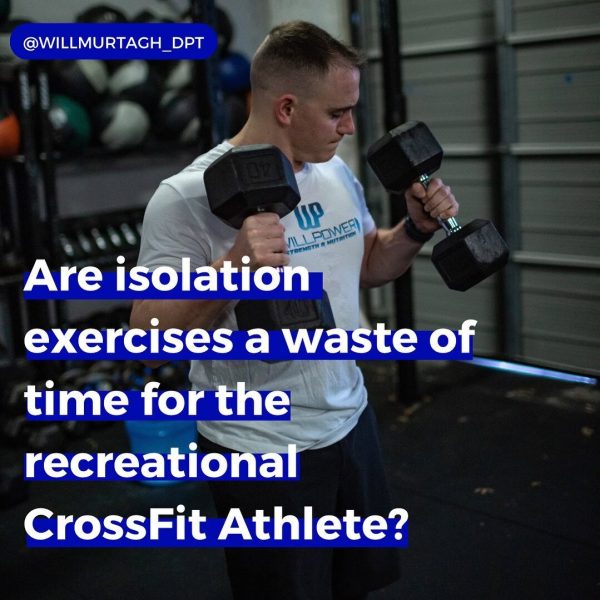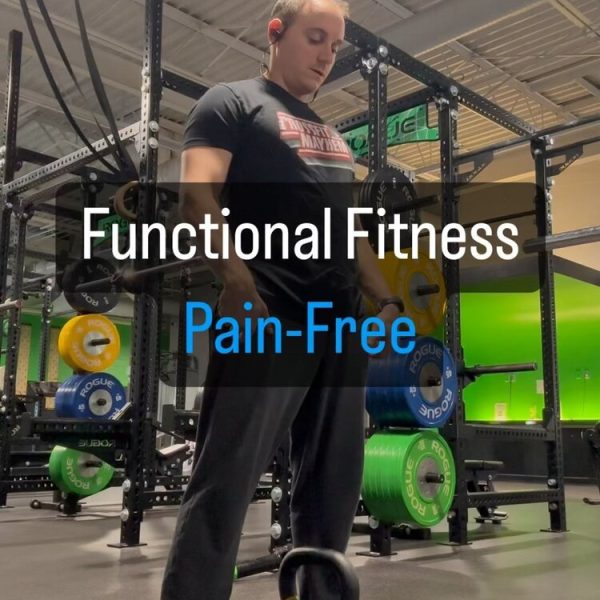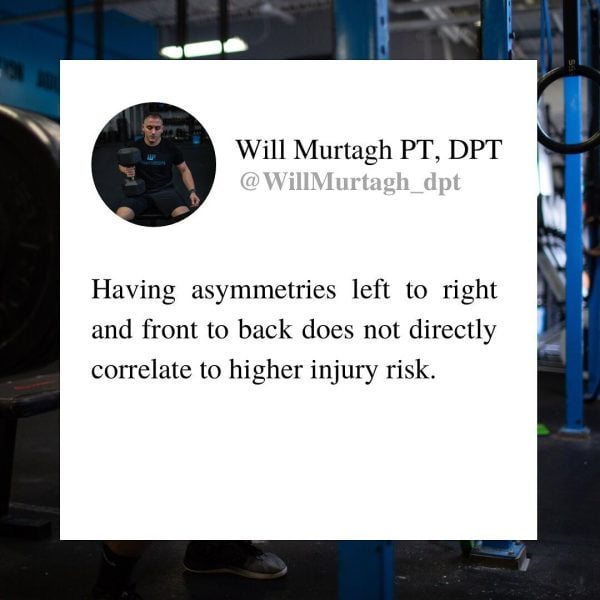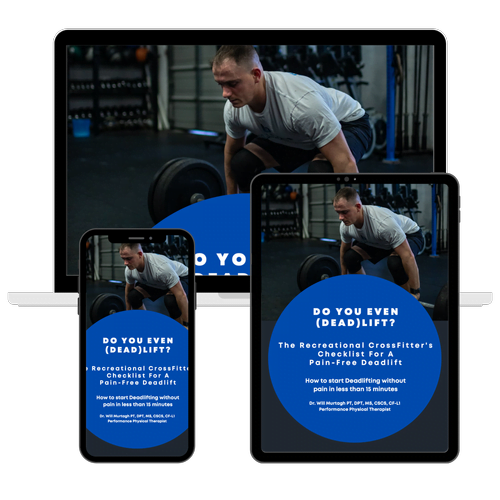Dr. Will Murtagh is a performance physical therapist and writer who helps Fitness Athletes elevate their fitness and train pain-free.
Research supports that CrossFit training fosters an improved sense of community, satisfaction, and motivation with your training. (1) It is a perfectly blended strength & conditioning program that combines the ten aspects of fitness, including Cardiovascular/respiratory endurance, strength, flexibility, power, speed, coordination, agility, balance, and accuracy.
Over my last 12 years as a Performance Physical Therapist and a CrossFit coach, I have seen this true in my clients, who can make considerable improvements in how they look, feel, and perform as they train in CrossFit. Inside my Pain-Free Performance Program, where I help CrossFitters elevate their fitness and train pain-free.
Since CrossFit training is so varied, it typically involves several different kinds of equipment, such as cyclical machines, barbells, and kettlebells. These may only sometimes be available to you if you train at home, are traveling, or are in a traditional gym setting.
Fortunately, several bodyweight CrossFit workouts can give you an excellent training session and challenge you physically. Over my last 12 years coaching CrossFitters, I have prescribed and done these fifteen bodyweight CrossFit workouts myself and know how potent they can be.
Give them a shot, and let me know how you did!
What Are the Best 15 Bodyweight Crossfit Workouts?
Optional Equipment
Annie
For Time:
50-40-30-20-10 Reps of:
Double-unders (or single-unders)
Sit ups
Cindy
AMRAP in 20 minutes:
5 Pull-ups
10 Push-ups
15 Air squats
Mary
AMRAP in 20 minutes:
5 Handstand push-ups
10 Pistols (alternating legs)
15 Pull-ups
Barbara
5 Rounds for Time:
20 Pull-ups
30 Push-ups
40 Sit-ups
50 Air squats
(rest 3 minutes between rounds)
Angie
For Time:
100 Pull-ups
100 Push-ups
100 Sit-ups
100 Air squats
Loredo
6 Rounds for Time:
24 Air squats
24 Push-ups
24 Walking lunges
400-meter run
Chelsea
EMOM for 30 minutes:
5 Pull-ups
10 Push-ups
15 Air squats
JT
21-15-9 Reps For Time
Handstand Push-Ups
Ring Dips
Push-Ups
Hey Buddy
For Time
Buy-In:
250 meter Run
Then, 5 Rounds of:
10 Lunges
10 Air Squats
10 Sit-Ups
8 Burpees
Cash-Out:
250 meter Run
Nicole
AMRAP in 20 minutes:
400-meter run
Max reps Pull-ups
Murph
For time:
1-mile run
100 pull-ups
200 push-ups
300 air squats
1-mile run
Leg Assault
5 Rounds for time:
20 walking lunges
15 pistol squats (alternating legs)
10 squat jumps
Gymnastics Tester
5-minute AMRAP
Strict Pull-Ups
-5-minute rest-
5-minute AMRAP
Strict handstand push-ups
Muscle Up Tester
For Time:
30 bar muscle ups
Sprint On The Minute
20 Minute E2MOM
200-meter sprint
What Is A Bodyweight WOD?
CrossFit bodyweight workouts or WODs (workout of the day) consist of bodyweight exercises only. No other equipment is used in designing the session, such as barbells, dumbbells, or kettlebells.
They also don’t involve cyclical machines such as assault bikes, concept 2 rowers, or concept 2 ski ergs. The workouts commonly incorporate a combination of functional movements targeting different muscle groups and energy systems with the intent of improving strength, endurance, agility, and overall fitness.
A bodyweight CrossFit workout will include movements like squats, push-ups, pull-ups, lunges, burpees, sit-ups, and box jumps, to name a few. The workout style can vary greatly and range from a high-intensity workout to a long-duration aerobic endurance workout.
The Types of Bodyweight WODs
CrossFit workouts that emphasize only bodyweight and either no to minimal equipment will come in various types and focus on different aspects of fitness, such as strength, muscle endurance, agility, stamina, and skill development.
Below are several CrossFit workout structures you will commonly see whether you are working out at home, in a hotel room, or in one of the ten thousand CrossFit boxes worldwide.
AMRAP (As Many Rounds/Reps As Possible)
In AMRAP workouts, you will attempt to complete the most work possible in a given time frame. You will cycle through rounds and repetitions of various exercises until the clock strikes zero. These workouts are predicated on achieving your most sustainable pace for the given time domain. They will be based on your aerobic conditioning, muscle endurance, and mental toughness.
For Time
Time workouts differ from AMRAP workouts in that they have a task priority, with the goal of completing the set amount of work as quickly as possible. These workouts emphasize movement speed, efficiency, and pacing to mitigate drops in muscle endurance or failed repetitions so that the job is done quickly.
EMOM (Every Minute on the Minute)
EMOM workouts are intervals that require you to perform a set number of repetitions or work for a specific amount of time with each passing minute. Once the necessary work is completed in the first minute, you’ll rest until the top of the next minute and either begin the same movement again or move on to the next one. These kinds of workouts help develop your “battery” or ability to recharge from high-intensity efforts and familiarize you with what kind of pacing is possible for you.
Tabata
Tabata-style workouts were popular with Dr. Izumi Tabata, a Japanese researcher and professor, in the mid-1990s. Dr. Izumi conducted a study that found that Tabata intervals consisting of eight rounds of twenty seconds of work followed by ten seconds of rest allowed for more work per session. (2) This maximizing of work leads to significant increases in both aerobic and anaerobic fitness levels. (2)
Chipper
Chipper workouts are a kind of “For Time” workout; however, they differ from the traditional format in that you will perform all of the repetitions of one movement before moving on to the next movement. These style workouts typically have a higher volume of repetitions, and the goal is to “chip away” at the total workload until all of it is completed.
These kinds of workouts are exceptionally challenging because you must be very familiar with your muscle endurance levels as you perform large amounts of volume per exercise. Thus, if you reach muscular failure, your performance in a chipper will drop significantly as you struggle to complete the work for each exercise.
Skill-Based
Bodywight-only CrossFit workouts can also focus solely on developing proficiency in specific gymnastic skills. These could be handstand push-ups, muscle-ups, pistol squats, or double-unders. For skill-based workouts, you will often find skill progressions, upper body and lower body drills, and non-fatiguing technique work to help improve coordination and body control.
Interval Training
Interval training workouts alternate between periods of high-intensity work followed by varying seconds of rest or lower-intensity work. Interval training in CrossFit workouts may incorporate AMRAPs, For Time, Chipper, or Tabata-style workouts. Each can be structured to have a set amount of work performed, followed by a rest period and additional sets afterward.
Benefits of Bodyweight WODs
Accessibility and Convenience
The primary benefit of bodyweight CrossFit workouts is how accessible and convenient they are. Because they require minimal to no equipment and emphasize your body weight for resistance, they can be performed almost anywhere, whether you’re performing home workouts, traveling, or outside in a park. This decreases the barrier to training and makes it easier to remain consistent with your training.
Functional Strength and Mobility
CrossFit workouts emphasize functional fitness, strength, and mobility to develop a general and inclusive fitness capable of any physical tasks that may be easily thrown at you. This fact remains the same with bodyweight workouts. You will perform functional movements such as squats, push-ups, pull-ups, and lunges, which engage the whole body and multiple muscle groups to provide an effective workout.
Scalability and Adaptability
Since there is little to no equipment in bodyweight CrossFit workouts, they are very scalable. They can be adapted to fit almost any fitness level. Whether you are a beginner CrossFitter or a seasoned veteran training for the CrossFit Games, you can get a good workout with only your body weight.
I have designed bodyweight-only workouts with reduced complexity for clients on day one of their CrossFit journeys, and I have seen CrossFit athletes at the highest level of the sport become humbled by bodyweight-only CrossFit Hero WODs done in competition.
Cardiovascular Conditioning and Fat Loss
Workouts that utilize your body weight and follow the workout structures listed above can be an excellent way to train your cardiovascular system and promote fat loss. Exercises like burpees, double-unders, mountain climbers, and pull-ups can elevate your heart rate and increase your metabolic demand.
When these movements are done at high intensity, an oxygen debt occurs called Excess Post Exercise Oxygen Consumption (EPOC), elevating your caloric burn throughout the day and enhancing fat loss. (3)
Drawbacks of Bodyweight WODs
Limited Load Progression
The main drawback of CrossFit workouts that rely on your body weight only is that there is a limited capacity to progress load for strength development. Unlike workouts that utilize barbells, kettlebells, or dumbbells, the strength development that can occur with bodyweight-only workouts will be related to relative strength or the ability to handle your body weight.
This can be challenging if you hope to compete in CrossFit or develop large amounts of strength, as the external load will be needed at some point for these endeavors.
Risk of Overuse Injuries
Since bodyweight exercises often require large amounts of volume to create a training stimulus, overuse injuries can increase. Overuse injuries, such as tendonitis, can be caused by spikes in workload that the tendon was unprepared for and are common in the upper body during CrossFit workouts. (4) Performing repetitive movements without proper volume accumulation and recovery can lead to strain, inflammation, and joint wear and tear over time.
Limited Exercise Variety
Although bodyweight exercises can cover a wide range of muscle groups and movement patterns, such as push, pull, squat, hinge, lunge, and core, they may lack variety because of the lack of equipment. Access to weights, resistance bands, and cardio machines can help avoid being burnt out from repeatedly performing the same exercises. This lack of variety can contribute to plateaus and a lack of progress over time.
Difficulty Progressing Beyond Bodyweight
As you become more proficient with bodyweight exercises, it becomes increasingly difficult to progress and challenge yourself further without external loads. Although you can add in movements like one-arm push-ups or pistol squats, these movements require other aspects of fitness, such as mobility that may take longer to develop than your work capacity will. It may be a struggle to advance in your fitness training without the ability to add an external load.
Lack of Skill Development in Weightlifting
A large part of CrossFit is developing the Olympic Weightlifting movements such as Clean, Jerk, and Snatch. These movements are predicated on how well you can move a barbell, and thus, bodyweight-only workouts will not allow for this development. Even with the power development of exercises like vertical jumps, squat jumps, or box jumps, the movements in Olympic Weightlifting are complex skills themselves and need to be practiced to be improved.
Wrapping Up On Bodyweight Crossfit Workouts
Bodyweight CrossFit workouts can be an excellent choice if you want to challenge your fitness and need access to equipment. Whether performing the classic CrossFit Hero WODs like Murph or JT or simply taking on some EMOM-style sprints, you can get an effective workout with nothing more than your body weight. If you are up for it, give the workouts I have listed a shot and experience how challenging and effective they can be for yourself.
If you have any questions, feel free to reach out and ask me!
If you are ready to elevate your fitness and train without nagging pain and injury, I would love to chat to learn more about your goals and how I can help you achieve them faster with my 1:1 Pain-Free Performance Program!
I invite you to take advantage of your free consultation by clicking HERE. I look forward to speaking with you!
FAQ
Do CrossFitters do full-body workouts?
CrossFit workouts are based on multi-joint compound movements that incorporate full-body exercises and workouts that engage the upper and lower body together.
How many times a week should you do CrossFit?
How often you should train CrossFit per week depends on various factors such as your fitness goals, training age, biological age, recovery ability, and experience level.
As a general rule of thumb, beginners can start at 3-4 sessions per week with full-body workouts; Intermediate CrossFitters can increase training frequency to 4-6 sessions per week and incorporate split training to allow for increases in load after the beginner stage.
Lastly, Advanced athletes may increase their sessions per week to 7+ as they develop a tolerance to large amounts of work and prepare for competition. At this level, monitoring load is crucial to managing stress on the nervous system and preventing overtraining.
How long does it take to see results from CrossFit?
The timeline for seeing results from CrossFit depends largely on your individual goals and the results you are after. For example, if your goal is weight loss, it is not uncommon to see weight decreases of several pounds per week right away, especially if you are overweight to start.
However, if you want to increase your competitive performance or build strength. In that case, it may be 3-6 weeks or more before you see the results of your training. If you are truly looking to transform your fitness and physique, then 3-6 months is when you will begin to not recognize yourself.
References;
1. Claudino, J. G., Gabbett, T. J., Bourgeois, F., Souza, H. S., Miranda, R. C., Mezêncio, B., Soncin, R., Cardoso Filho, C. A., Bottaro, M., Hernandez, A. J., Amadio, A. C., & Serrão, J. C. (2018). CrossFit Overview: Systematic Review and Meta-analysis. Sports medicine – open, 4(1), 11. https://doi.org/10.1186/s40798-018-0124-5
2. Tabata I. (2019). Tabata training: one of the most energetically effective high-intensity intermittent training methods. The journal of physiological sciences : JPS, 69(4), 559–572. https://doi.org/10.1007/s12576-019-00676-7
3. Greer, B. K., O’Brien, J., Hornbuckle, L. M., & Panton, L. B. (2021). EPOC Comparison Between Resistance Training and High-Intensity Interval Training in Aerobically Fit Women. International journal of exercise science, 14(2), 1027–1035. https://pubmed.ncbi.nlm.nih.gov/34567357/
4. Nicolay, R. W., Moore, L. K., DeSena, T. D., & Dines, J. S. (2022). Upper Extremity Injuries in CrossFit Athletes-a Review of the Current Literature. Current reviews in musculoskeletal medicine, 15(5), 402–410. https://doi.org/10.1007/s12178-022-09781-4

